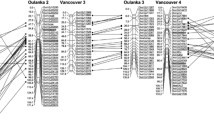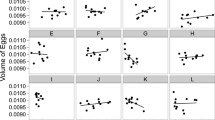Abstract
Sexual isolation has been considered one of the primary causes of speciation and its genetic study has the potential to reveal the genetics of speciation. In Drosophila, the importance of courtship songs in sexual isolation between closely related species has been well investigated, but studies analysing the genetic basis of the difference in the courtship songs associated with sexual isolation are less well documented. Drosophila ananassae and Drosophila pallidosa are useful for studies of sexual isolation, because of their sympatric distribution and absence of postmating isolation. Courtship songs are known to play a crucial role in sexual isolation between these two species, and the female discrimination behaviour against the courting male has been revealed to be controlled by a very narrow region on the second chromosome. In this study we investigated the genetic basis controlling the song differences associated with their sexual isolation, using intact and wingless males with chromosomes substituted between species. The results obtained from F1 hybrid males between these species indicate the dominance of the song characters favoured by D. pallidosa females. In addition, the results obtained from backcross F2 males indicate that chromosome 2 had a major effect on the control of the song characters associated with sexual isolation.
Similar content being viewed by others
References
Bennet-Clark, H.C. & A.W. Ewing, 1969. Pulse interval as a critical parameter in the courtship song of Drosophila melanogaster. Anim. Behav. 17: 755–759.
Bock, I.R. & M.R. Wheeler, 1972. The Drosophila melanogaster species group. Univ. Tex. Publ. 7213: 1–102.
Cabot, E.L., A.W. Davis, N.A. Johnson & C.I. Wu, 1994. Genetics of reproductive isolation in the Drosophila simulans clade: complex epistasis underlying hybrid male sterility. Genetics 137: 175–189.
Charlesworth, B., J.A. Coyne & N.H. Barton, 1987. The relative rates of evolution of sex chromosomes and autosomes. Am. Nat. 130: 113–146.
Cobb, M. & J.-F. Ferveur, 1996. Evolution and genetic control of mate recognition and stimulation in Drosophila. Behav. Proc. 35: 35–54.
Cowling, D.E. & B. Burnet, 1981. Courtship songs and genetic control of their acoustic characteristics in sibling species of Drosophila melanogaster subgroup. Anim. Behav. 29: 924–935.
Coyne, J., 1996. Genetics of sexual isolation in male hybrids of Drosophila simulans and D. mauritiana. Genet. Res. Camb. 68: 211–220.
Crossley, S., 1986. Courtship sounds and behaviour in the four species of the Drosophila bipectinata complex. Anim. Behav. 34: 1146–1159.
Davis, A.W. & C.I. Wu, 1996. The broom of sorcerer's apprentice: the fine structure of a chromosomal region causing reproductive isolation between two sibling species of Drosophila. Genetics 143: 1287–1298.
Davis, A.W., E.G. Noonburg & C.I. Wu, 1994. Evidence for complex genetic interactions between conspecific chromosomes underlying hybrid female sterility in the Drosophila simulans clades. Genetics 137: 191–199.
Doi, M., T. Nemoto, H. Nakanishi, Y. Kuwahara & Y. Oguma, 1997. Behavioral response of males to major sex pheromone component, (Z,Z)-5,25-hentriacontadiene, of Drosophila ananassae females. J. Chem. Ecol. 23: 2067–2078.
Doi, M., M. Matsuda, M. Tomaru, H. Matsubayashi & Y. Oguma, 2001. A locus for female discrimination behavior causing sexual isolation in Drosophila. Proc. Natl. Acad. Sci. USA 98: 6714–6719.
Ehrman, L., 1961. The genetics of sexual isolation in Drosophila paulistrum. Genetics 46: 1025–1038.
Ewing, A.W., 1969. The genetic basis of sound production in Drosophila pseudoobscura and D. persimilis. Anim. Behav. 17: 555–560.
Ewing, A.W., 1983. Functional aspects of Drosophila courtship. Biol. Rev. 58: 275–292.
Ewing, A.W. & H.C. Bennet-Clark, 1968. The courtship songs of Drosophila. Behaviour 31: 288–301.
Ewing, A.W. & J.A. Miyan, 1986. Sexual selection, sexual isolation and the evolution of song in the Drosophila repleta group of species. Anim. Behav. 34: 421–429.
Futch, D.G., 1966. III. A study of speciation in South Pacific population of Drosophila ananassae. Univ. Tex. Publ. 6615: 79–120.
Futch, D.G., 1973. On the ethological differentiation of Drosophila ananassae and Drosophila pallidosa in Samoa. Evolution 27: 456–467.
Hall, J.C., 1994. The mating of a fly. Science 264: 1702–1714.
Hoikkala, A., S. Paallysaho, J. Aspi & J. Lumme, 2000. Localization of genes affecting species differences in male courtship song between Drosophila virilis and D. littoralis. Genet. Res. Camb. 75: 37–45.
Isoherranen, E., J. Aspi & A. Hoikkala, 1999. Variation and consistency of female preference for simulated courtship songs in Drosophila virilis. Anim. Behav. 57: 619–625.
Kyriacou, C.P. & J.C. Hall, 1980. Circadian rhythm mutations in Drosophila melanogaster affect short-term fluctuations in the male's courtship song. Proc. Natl. Acad. Sci. USA 77: 6729–6733.
Kyriacou, C.P. & J.C. Hall, 1982. The function of courtship song rhythms in Drosophila. Anim. Behav. 30: 794–801.
Neems, R.M., K. Dooher, R.K. Butlin & B. Shorrocks, 1997. Differences in male courtship song among the species of the quinaria group of Drosophila. J. Insect. Behav. 10: 237–246.
Nemoto, T., M. Doi, K. Oshio, H. Matsubayashi, Y. Oguma, T. Suzuki & Y. Kuwahara, 1994. (Z,Z)-5,27-tritriacontadiene: major sex pheromone of Drosophila pallidosa (Diptera: Drosophilidae). J. Chem. Ecol. 20: 3029–3037.
Noor, M.A.F., 1997. Genetics of sexual isolation and courtship dysfunction in male hybrids of Drosophila pseudoobscura and Drosophila persimilis. Evolution 51: 809–815.
Noor, M.A.F. & C.F. Aquadro, 1998. Courtship songs of Drosophila pseudoobscura and D. persimilis: analysis of variation. Anim. Behav. 56: 115–125.
Oguma, Y., 1993. Sexual Behavior (Chapter 10), pp. 199–207 in Drosophila ananassae: Genetical and Biological Aspects, edited by Tobari. Jap. Sci. Soc. Press.
Palopoli, M.F. & C.I. Wu, 1994. Genetics of hybrid male sterility between Drosophila sibling species: a complex web of epistasis if revealed in interspecific studies. Genetics 138: 329–341.
Pugh, A.R. & M. Ritchie, 1996. Polygenic control of a mating signal in Drosophila. Heredity 77: 378–382.
Ritchie, M.G. & Phillips, S.D.F., 1998. The Genetics of Sexual Isolation, pp. 291–308 in Endless Forms-Species and Speciation, edited by D.J. Howard & S.H. Berlocher. Oxford University Press, New York.
Ritchie, M.G., R.M. Townhill & A. Hoikkala, 1998. Female preference for fly song: playback experiments confirm the targets of sexual selection. Anim. Behav. 56: 713–717.
Spieth, H.T., 1966. V. Mating behavior of D. ananassae and ananassae-like flies from the Pacific. Univ. Tex. Publ. 6615: 133–145.
Stone, W.S., M.R. Wheeler, F.D. Wilson, V.L. Gerstenberg & H. Yang, 1966. I. Genetic studies of natural population of Drosophila II. Pacific island populations. Univ. Tex. Publ. 6615: 1–36.
Tobari, Y.N., 1993. Drosophila ananassae: Genetical and Biological Aspects. Jap. Sci. Soc. Press.
Tomaru, M. & Y. Oguma, 1994a. Differences in courtship song in the species of the Drosophila auraria complex. Anim. Behav. 47: 133–140.
Tomaru, M. & Y. Oguma, 1994b. Genetic basis and evolution of species-specific courtship song in the Drosophila auraria complex. Genet. Res. Camb. 63: 11–17.
Tomaru, M., H. Matsubayashi & Y. Oguma, 1995. Heterospecific inter-pulse intervals of courtship song elicit female rejection in Drosophila biauraria. Anim. Behav. 50: 905–914.
Williams, M.A., A.G. Blouin & M.A.F. Noor, 2001. Courtship songs of Drosophila pseudoobscura and D. persimilis. II. Genetics of species differences. Heredity 86: 68–77.
Yamada, H., T. Sakai, M. Tomaru, M. Doi, M. Matsuda & Y. Oguma, 2002. Search for species-specific mating signal in courtship songs of sympatric sibling species, Drosophila ananassae and D. pallidosa. Genes Genet. Syst. 77: 97–106.
Author information
Authors and Affiliations
Rights and permissions
About this article
Cite this article
Yamada, H., Matsuda, M. & Oguma, Y. Genetics of Sexual Isolation Based on Courtship Song between Two Sympatric Species: Drosophila Ananassae and D. Pallidosa . Genetica 116, 225–237 (2002). https://doi.org/10.1023/A:1021261215905
Issue Date:
DOI: https://doi.org/10.1023/A:1021261215905




